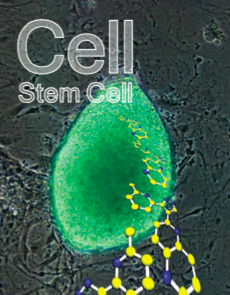 In order to turn adult cells back into pluripotent or embryonic-like stem cells, scientists use viruses to insert four genes – Sox2, Oct4, Klf4, and cMyc – into the cells. These reprogrammed cells, called induced pluripotent stem cells (iPS cells), have generated a huge amount of excitement in the field. However, because some of those genes and viral vectors used to insert them have the potential to cause cancer, iPS cell lines are not clinically useful.
In order to turn adult cells back into pluripotent or embryonic-like stem cells, scientists use viruses to insert four genes – Sox2, Oct4, Klf4, and cMyc – into the cells. These reprogrammed cells, called induced pluripotent stem cells (iPS cells), have generated a huge amount of excitement in the field. However, because some of those genes and viral vectors used to insert them have the potential to cause cancer, iPS cell lines are not clinically useful.
Consequently, researchers have been looking for ways to replace those factors since the reprogramming process was first discovered. This October in the journal Cell Stem Cell, HSCI Principal Faculty members Kevin Eggan, PhD, and Lee Rubin, PhD, and colleagues published their discovery of a single chemical that replaces two of the genes used in reprogramming. The small molecule, which the team named RepSox in honor of another Boston team, replaces Sox2 and cMyc, two genes associated with cancer.
“This demonstrates that we’re half-way home, and remarkably we got half-way home with just one chemical,” Eggan said. “The one chemical replaces those two genes in different ways at different times in the experiment.”
Finding a way to produce safe iPS cells that are the biological equivalent of embryonic stem cells is especially important because, ultimately, iPS cells can be created from individual patients for transplantation back into those same patients. Thus a person with Parkinson’s might be treated with neurons created from his own cells, theoretically eliminating the need for immunosuppressive drugs, or the possibility of rejection of the transplanted cells.
“This discovery is exciting because it demonstrates the feasibility of using chemicals to make safer patient-specific stem cells for transplantation medicine,” said Justin Ichida, PhD, a postdoctoral fellow in Eggan’s lab and the first author on the study. “One of the most important things we learned from this study is that with respect to molecular pathways, there may be several ways to convert one type of cell into another. By using a non-biased chemical screening approach, we uncovered a previously unknown way to make stem cells. The big challenge over the next decade will be to figure out how to make the right cells for disease treatment. This approach will be important for achieving that goal.”
In addition to problems of safety, reprogramming thus far been a very inefficient process – only about one in every 1,000 mature cells is successfully reprogrammed. HSCI Principal Faculty member Konrad Hochedlinger, PhD, and colleagues have recently shown two ways to substantially improve the odds of successfully creating iPS cell lines: selecting immature cells rather than their more mature counterparts for reprogramming; and blocking the activity of the gene that instructs the cells to stop dividing.
Because it’s been difficult to reprogram mature differentiated cells, the team focused its effort on a population of relatively rare progenitor cells – cells that are heading down a particular developmental pathway but are not yet turned into the eventual cell type. Progenitor cells can give rise to a number of mature cell types within a given tissue type. “By attempting to reprogram a population of progenitor cells, you have a way to increase efficiency,” Hochedlinger said. Approximately 300 cells out of 1,000 successfully transform into an iPS cell by starting the reprogramming process with progenitor cells.
“The second solution we came up with was identifying molecules whose manipulation enhances the cell division cycle, the proliferation of the cells, and thereby also enhances the efficiency of the reprogramming,” Hochedlinger said.
Normally, adult cells have a limited number of cell divisions they can go through before they stop dividing. “Certain molecules turn on to tell the cell ‘stop dividing now,’” he said. “We find that if we inactivate the molecule, it makes the cell continue dividing. And we can increase the efficiency of reprogramming by making the cell grow indefinitely.”
The work is an important step in “fine-tuning” the science of creating iPS cells. Producing iPS cells en masse will provide researchers a way to study diseases in the laboratory, as well as provide targets for drug development, and possibly replace damaged or malfunctioning tissue responsible for many hitherto incurable, chronic diseases.
Recent work published by Kevin Eggan,PhD, and Lee Rubin,PhD, appeared on the cover of the scientific journal Cell Stem Cell.
